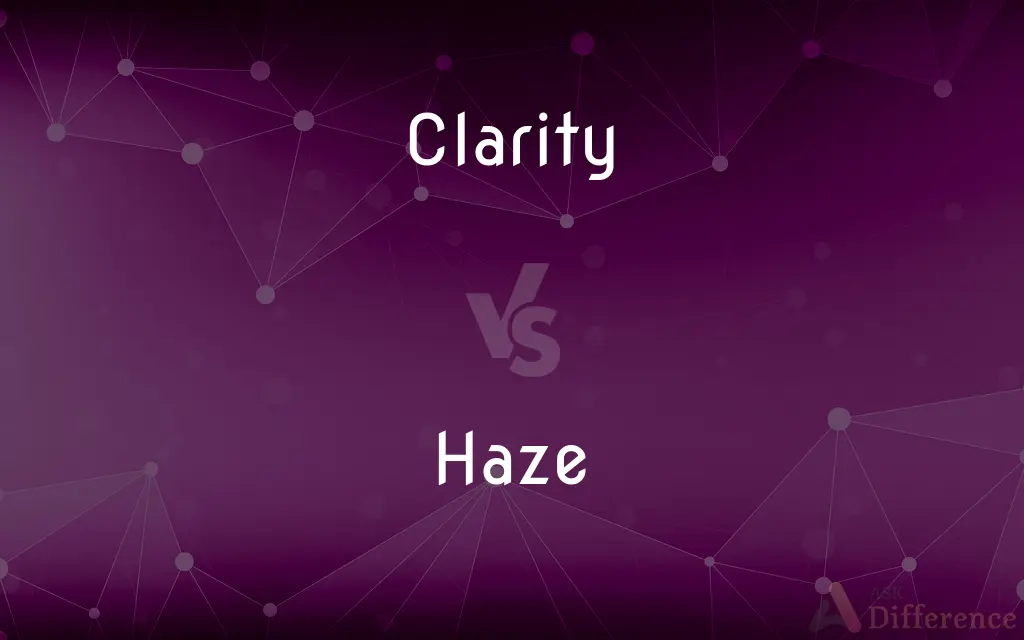Clarity vs. Haze — What's the Difference?
By Tayyaba Rehman & Urooj Arif — Updated on April 20, 2024
Clarity refers to the quality of being clear and understandable, often used in describing transparent substances or concepts, while haze describes a state of atmospheric obscurity due to particles, affecting visibility.

Difference Between Clarity and Haze
Table of Contents
ADVERTISEMENT
Key Differences
Clarity in a substance, like water or glass, means it is free from impurities or obscurities, allowing light to pass through unimpeded. On the other hand, haze is specifically an atmospheric condition where particles like dust, smoke, or moisture blur visibility, creating a diffused glow around lights.
In communication, clarity is achieved through precise, simple, and coherent language that enhances understanding and minimizes confusion. Whereas, haze could metaphorically describe communication that is muddled, vague, or lacking in directness, which obscures the intended message.
Visual artists might strive for clarity in their work to ensure viewers perceive and interpret it as intended, emphasizing crisp lines and vivid details. In contrast, some artists use haze as a technique to convey mystery, depth, or the illusion of distance in their paintings or photographs.
In literature, clarity is often pursued to ensure that the narrative or prose is accessible and impactful to the reader. Conversely, a writer might intentionally employ a 'hazy' style using ambiguous terms and complex metaphors to challenge the reader or evoke specific moods.
In science, particularly in optics and meteorology, clarity is quantifiable and desirable in environments like laboratories where precision is crucial. Meanwhile, haze is often studied as a phenomenon affecting climate, environmental quality, and health, necessitating measurement and mitigation.
ADVERTISEMENT
Comparison Chart
Definition
Clearness and transparency
Obscurity caused by particles
Contexts
Visual, communication, science
Atmospheric, visual arts
Desired Outcome
Enhanced understanding
Reduced visibility
Measurement
Through purity and precision
Particle concentration
Associated Technique
Precise language or optics
Use of diffused lighting
Compare with Definitions
Clarity
The quality of being clear and understandable.
The clarity of the crystal made it appear almost invisible.
Haze
A light mist or smoke that obscures visibility.
A thin haze hovered over the field after the fireworks.
Clarity
The state of being free from noise or interference.
The audio recording was remarkable for its clarity.
Haze
Atmospheric condition obscuring clarity.
The morning haze made the commute challenging.
Clarity
Transparency or purity of a substance.
The clarity of the lake's water is due to its cleanliness.
Haze
A state or atmosphere of vagueness or obscurity.
The discussion was lost in a haze of technical jargon.
Clarity
Clearness of expression or thought.
His explanation lacked clarity and left everyone confused.
Haze
A filmy or cloudy appearance.
There's a haze on the window that needs cleaning.
Clarity
Freedom from ambiguity in communication.
She appreciated the clarity of the instructions in the manual.
Haze
Diffuse light or glow in photography or cinematography.
The photographer used a haze filter to create a dreamy effect.
Clarity
The quality of being coherent and intelligible
For the sake of clarity, each of these strategies is dealt with separately
Haze
Haze is traditionally an atmospheric phenomenon in which dust, smoke, and other dry particulates obscure the clarity of the sky. The World Meteorological Organization manual of codes includes a classification of horizontal obscuration into categories of fog, ice fog, steam fog, mist, haze, smoke, volcanic ash, dust, sand, and snow.
Clarity
The quality of transparency or purity
The crystal clarity of water
Haze
A slight obscuration of the lower atmosphere, typically caused by fine suspended particles
The cold air has no pollution and very little haze
There was a thick haze on this October morning
Clarity
Clearness of appearance
The clarity of the mountain air.
Haze
A state of mental confusion
An alcoholic haze
Clarity
Clearness of thought or style; lucidity
Writes with clarity and perception.
Haze
Obscure with a haze
A clump of islands, very green, but hazed in cloud and mist
Clarity
The state or measure of being clear, either in appearance, thought or style; lucidity.
She dreamed with great clarity.
The brilliant clarity of his argument could not be faulted.
Haze
Force (a new or potential recruit to the military or a university fraternity) to perform strenuous, humiliating, or dangerous tasks
Rookies were mercilessly hazed
Clarity
The ability to be easily understood.
Lack of clarity on the part of the teacher will cause confusion among the students.
Haze
Drive (cattle) while on horseback
He hazed them on and they clambered up through the rocks
Clarity
Clearness; brightness; splendor.
Floods, in whose more than crystal clarity,Innumerable virgin graces row.
Haze
Atmospheric moisture, dust, smoke, and vapor that diminishes visibility.
Clarity
Free from obscurity and easy to understand; the comprehensibility of clear expression
Haze
A partially opaque covering
Let the polish dry to a haze before buffing it.
Clarity
The quality of clear water;
When she awoke the clarity was back in her eyes
Haze
A vague or confused state of mind.
Haze
To become misty or hazy; blur.
Haze
To persecute or harass with meaningless, difficult, or humiliating tasks.
Haze
To initiate, as into a college fraternity, by exacting humiliating performances from or playing rough practical jokes upon.
Haze
Very fine solid particles (smoke, dust) or liquid droplets (moisture) suspended in the air, slightly limiting visibility. fog, mist.}}
Haze
A reduction of transparency of a clear gas or liquid.
Haze
An analogous dullness on a surface that is ideally highly reflective or transparent.
The soap left a persistent haze on the drinking glasses.
The furniture has a haze, possibly from some kind of wax.
Haze
(figuratively) Any state suggestive of haze in the atmosphere, such as mental confusion or vagueness of memory.
Haze
The degree of cloudiness or turbidity in a clear glass or plastic, measured in percent.
Haze
Any substance causing turbidity in beer or wine.
Haze
To be or become hazy, or thick with haze.
Haze
To perform an unpleasant initiation ritual upon a usually non-consenting individual, especially freshmen to a closed community such as a college fraternity or military unit.
Haze
To oppress or harass by forcing to do hard and unnecessary work.
Haze
(transitive) In a rodeo, to assist the bulldogger by keeping (the steer) running in a straight line.
Haze
(transitive) To use aversive stimuli on (a wild animal, such as a bear) to encourage it to keep its distance from humans.
Haze
Light vapor or smoke in the air which more or less impedes vision, with little or no dampness; a lack of transparency in the air; hence, figuratively, obscurity; dimness.
O'er the skyThe silvery haze of summer drawn.
Above the world's uncertain haze.
Haze
A state of confusion, uncertainty, or vagueness of thought or perception; as, after the explosion, people were wandering around in a haze.
Haze
To be hazy, or thick with haze.
Haze
To harass by exacting unnecessary, disagreeable, or difficult work.
Haze
To harass or annoy by playing abusive or shameful tricks upon; to humiliate by practical jokes; - used esp. of college students, as an initiation rite into a fraternity or other group; as, the sophomores hazed a freshman.
Haze
Atmospheric moisture or dust or smoke that causes reduced visibility
Haze
Confusion characterized by lack of clarity
Haze
Become hazy, dull, or cloudy
Haze
Harass by imposing humiliating or painful tasks, as in military institutions
Common Curiosities
What is clarity?
It refers to the quality of being clear, transparent, or easily understandable.
Is clarity always a positive attribute?
In most contexts, clarity is seen as positive, enhancing understanding and effectiveness.
How can one improve clarity in writing?
Using simple, direct language and organizing thoughts logically improves clarity.
Can clarity be quantified?
Yes, in fields like optics, clarity can be quantified using measures of transparency and purity.
What causes atmospheric haze?
Haze is typically caused by dust, smoke, or other fine particles suspended in the air.
How does haze affect health?
Haze can impair respiratory function and exacerbate conditions like asthma and allergies.
What are the benefits of clear communication?
Clear communication minimizes misunderstandings and enhances efficiency.
What defines haze in meteorology?
Haze is defined by reduced visibility due to the presence of tiny particles in the air.
Why might an artist use haze in their work?
Artists use haze to add depth, mystery, or a specific atmospheric effect.
How do you remove haze from a photograph?
Haze can be reduced in photos using editing software that adjusts contrast and sharpness.
Share Your Discovery

Previous Comparison
Syntax vs. Semantics
Next Comparison
Proselytize vs. EvangelizeAuthor Spotlight
Written by
Tayyaba RehmanTayyaba Rehman is a distinguished writer, currently serving as a primary contributor to askdifference.com. As a researcher in semantics and etymology, Tayyaba's passion for the complexity of languages and their distinctions has found a perfect home on the platform. Tayyaba delves into the intricacies of language, distinguishing between commonly confused words and phrases, thereby providing clarity for readers worldwide.
Co-written by
Urooj ArifUrooj is a skilled content writer at Ask Difference, known for her exceptional ability to simplify complex topics into engaging and informative content. With a passion for research and a flair for clear, concise writing, she consistently delivers articles that resonate with our diverse audience.














































